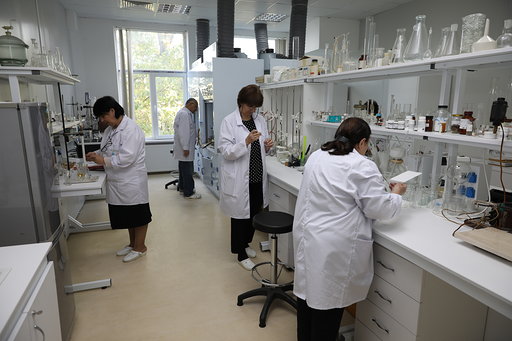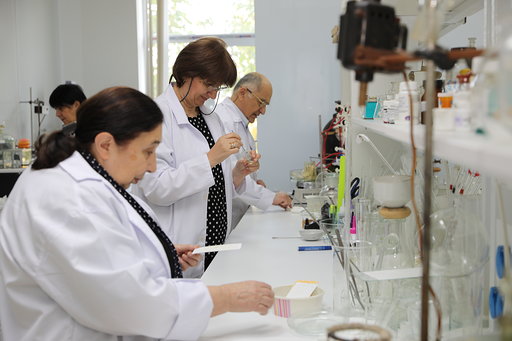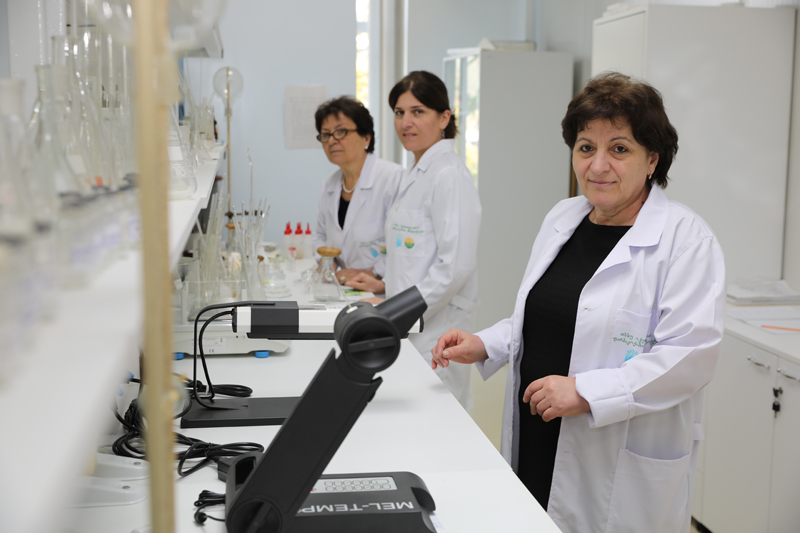*******
Personnel: Principal Research Scientist M. Merlani; Senior Research Scientists L. Amiranashvili; Senior Research Scientists L. Gogilashvili; Research Scientists V. Barbakadze
History: Laboratory of Plant Biopolymers was established in 2006. Since 2017 it is called as Direction of Plant Biopolymers. One master's and one doctoral works were performed in the Direction.
Goals: Isolation, structure elucidation, study of bioactivity of biopolymers from Georgian medicinal plants; search of monomer of targeted bioactive biopolymer in selected plants; synthesis of monomer, its derivatives, oligomers, polymeric analogues of bioactive biopolymers; comparison of bioactivity of natural and synthetic compounds, determination of their structure-activity relationship; determination of possibility for development of effective medicine.
Tasks: Isolation, structure elucidation and determination of bioactivity of biopolymers from Georgian medicinal plants; synthesis of monomers, their derivatives, oligomers and polymeric analogues of bioactive biopolymers by chemical and enzymatic methods; comparison of antioxidant, anti-inflammatory, wound healing and anti-cancer activity of natural and synthetic compounds; identification of low-molecular compounds from selected plants to detect the initial monomer of the targeted polymer.
Research Directions: Research of biologically active high- and low-molecular compounds of medicinal plants; synthesis of their analogues and study of pharmacological properties.
Research Methods: Obtaining and structure elucidation of bioactive biopolymers and low-molecular compounds; chemical and enzymatic synthesis of their analogues.
Learning Direction: Staffs of Direction have the appropriate competence to training qualified personnel in the field of isolation and structure elucidation of biologically active biopolymers from medicinal plants and synthesis of their analogues.
Expert-consulting Direction: Staffs of Direction fulfill consulting and expert activities within their competence.
Scientific Results: Investigation of water-soluble high molecular fractions (> 1000 kDa) from the species of Boraginaceae family: Symphytum asperum (prickly comfrey), S. caucasicum (Caucasian comfrey), S. officinale (common comfrey), S.grandiflorum (creeping comfrey), Anchusa italica (Italian bugloss) and Cynoglossum officinale (hound’s tongue). The main chemical constituent of which was found to be poly[3-(3,4-dihydroxyphenyl)glyceric acid] (p-DPGA). The repeating unit of this regular polymer is a 3-(3,4-dihydroxyphenyl)glyceric acid residue (m-DPGA). The obtained polymer is representative of a new class of natural polyethers. p-DPGA exhibited antioxidant, anti-inflammatory, wound healing and anti-cancer efficacy. The particular interest was its anti-cancer activity, which has been studied by in vitro and in vivo experiments against prostate cancer cells. The monomer of targeted polymer and its 65 different derivatives have been synthesized. The comparative studies have shown that the anti-cancer activity of p-DPGA was much more effective than its synthetic monomer m-DPGA. Thus, studies have identified p-DPGA as an anti-prostate cancer agent without any toxicity. In addition, the oligomeric derivatives of mentioned biopolymer have been obtained by chemical and enzymatic synthesis, the biological efficacy of which is being studied. Some low-molecular compounds from some species of Boraginaceae family have been identified.
Members of Direction were granted:
- 1. Georgian-U.S. Bilateral Grants Program III, GEB-3344-TB-06, 06.2007-12.2008.
- 2. Georgian National Science Foundation Grant GNSF/ST08 /6-469, 04.2009-04.2011.
- 3. Shota Rustaveli National Science Foundation Grant AR/109/8-403/11,
Agreement №10/21, 02.04.2012, 04.2012-04.2014.
Senior Research Scientist Maia Merlani obtained:
- 1. Matsumae International Research Fellowship 13G02, (Hokkaido University, Sapporo, Japan), 04.2013 - 10.2013.
- 2. Fulbright Visiting Scholars Program E0581303, 01.2018 – 07.2018.
- 3. Hokkaido University Research Promotion Fund’s Grant (Sapporo, Japan), 11.2018 - 05.2019.
Number of Articles -34.
Patent - 1.
Participation in international and local conferences – 60.
Collaboration: Hokkaido University, Sapporo, Japan; Syracuse University, Department of Chemistry, New York, USA; Aristotle University, School of Pharmacy, Thessaloniki, Greece; Iv. Javakhishvili Tbilisi State University, Institute of Physical and Analytical Chemistry.
Publication: Number of scientific articles published in 2015-2019 - 11; Participation in local and international scientific conferences and symposiums - 15.
List of scientific articles published in the last 5 years:
- Э.П.Кемертелидзе, М.М.Бенидзе, А.В.,Схиртладзе, Н.Ш.Надараиа, М.И.Мерлани, Л.Ш.Амиранашвили. СИНТЕЗ СТЕРОИДНЫХ ГОРМОНАЛЬНЫХ ПРЕПАРАТОВ ИЗ ТИГОГЕНИНА ИНТРОДУЦИРОВАННОЙ В ГРУЗИИ YUCCAGLORIOSAL. И ИЗУЧЕНИЕ ХИМИЧЕСКОГО СОСТАВА РАСТЕНИЯ“. მონოგრაფია, საქართველოს მეცნიერებათა ეროვნული აკადემიისგამომცემლობა, თბილისი, 2018, 230 გვ.
- M. Merlani, V. Barbakadze, L.Amiranashvili, L. Gogilashvili. Synthesis of New Dihydroxylated Derivatives of Ferulic and Isoferulic Acids. Bull. Georg. Natl. Acad. Sci., 2018, V. 12, N 4, P. 119-124.
- N. Sh.Nadaraia, L Sh.Amiranashvili, M. Merlani , M.L.Kakhabrishvili, N.N.Barbakadze, A. Geronikaki, A.Petrou, V. Poroikov, A. Ciric J. Glamoclija, M. Sokovic. Novel antimicrobial agents’ discovery among the steroid derivatives. Steroids., 2019, 144, P.52-65
- M. Merlani, V. Barbakadze, L. Amiranashvili, L. Gogilashvili, V. Poroikov, A. Petrou, A. Geronikaki, A. Ciric, J. Glamoclijad, M. Sokovic. New Caffeic Acid Derivatives as Antimicrobial Agents: Design, Synthesis, Evaluation and Docking. Current Topics in Medicinal Chemistry. 2019, 19, 292-304,
- M.Merlani, Zh.Song, Y.Wang,Y.Yuan, J.Luo, V. Barbakadze, B. Chankvetadze, T. Nakano. Polymerization of Bulky of Oxirane Monomers Leading to Polyethers Exhibiting Intra-molecular Charge Transfer Interactions. Macromol. Chem. Phys. 2019, V. 220, N 23,1900331
- L Amiranashvili, N Nadaraia, M Merlani, C Kamoutsis, A Petrou, A. Geronikaki, P. Pogodin, D. Druzhilovskiy, V. Poroikov, A. Ciric, J. Glamočlija, M. Sokovic. Antimicrobial Activity of Nitrogen-Containing 5-α-Androstane Derivatives: In Silico and Experimental Studies. 2020, Antibiotics 9 (5), 224.
- L. Gogilashvili, L. Amiranashvili, M. Merlani, A. Salgado, B. Chankvetadze V. Barbakadze. Poly [3-(3, 4-Dihydroxyphenyl) Glyceric Acid] from Cynoglossum officinale L.(Boraginaceae). Bull. Georg. Natl. Acad. Sci., 2020, V. 14, N 1, P.108-113.
- V. Barbakadze, L. Gogilashvili, L. Amiranashvili, M. Merlani, Sh.P.Li, B. Chankvetadze. Fractionation of Biologically Active Poly[3-(3,4-Dihydroxyphenyl)Glyceric Acid] Preparation from Symphytum asperum, Simultaneous Determination of Molecular Weights and Contents of its Fractions Using HPSEC-MALLS-RID. Bull. Georg. Natl. Acad. Sci., 2021, V. 15, N 1, P.69-75
- V. Barbakadze, L. Gogilashvili, L. Amiranashvili, M. Merlani, Sh.P.Li, B. Chankvetadze. Fractionation of Biologically Active Poly[3-(3,4-Dihydroxyphenyl)Glyceric Acid] Preparation from Symphytum asperum, HPSEC-MALLS-RID and Membrane Ultrafiltration Methods. Bull. Georg. Natl. Acad. Sci., 2021, V. 15, N 2, P.115-119.
- V. Barbakadze, L. Gogilashvili, L. Amiranashvili, M. Merlani, Sh.P.Li, B. Chankvetadze. M. Churadze, A. Gogolashvili, A. Salgado, B. Chankvetadze. Carbohydrate-Based Biopolymers: BiologicallyActive Poly[3-(3,4-Dihydroxyphenyl)GlycericAcid]from Borago officinalis. Bull. Georg. Natl. Acad. Sci., 2021, V. 15, N 4, P.140-145
- T. Kekeishvili, M. Merlani, L.Amiranashvili, L.Gogilashvili, V.Barbakadzde. Biologically active poly[3-(3,4-Dihydroxyphenyl)Glyceric Acid] from Borago officinalis (Boraginacea). TMSU Collection of scientific works. 2022, v.55., p.85-87
- M. Merlani, V. Barbakadze, L. Amiranashvili, L. Gogilashvili, A. Petrou, A.
Geronikaki, A. Ćirić, J. Glamočlija & M. Soković. Caffeic and 3-(3,4-dihydroxyphenyl)glyceric acid derivatives as antimicrobial agent: biological evaluation and molecular docking studies. SAR AND QSAR IN ENVIRONMENTAL RESEARCH. 2022, VOL. 33, NO. 4, 307–321. - M. Merlani, D. M. Scheibel, V. Barbakadze, L. Gogilashvili, L. Amiranashvili,
A.Geronikaki, V. Catania, D. Schillaci, G. Gallo, I. Gitsov. Enzymatic synthesis and antimicrobial activity of oligomer analogues of medicinal biopolymers from comfrey and their species of the Boraginaceae Family. Pharmaceutics, 2022, v.14, N.1, 115 - V. Barbakadze, L. Gogilashvili, L. Amiranashvili, M. Merlani, M.Getia, A. Gogolashvili, A. Salgado, B. Chankvetadze. Biologically active sugar-based poly[3-(3,4-Dihydroxyphenyl)Glyceric Acid] from stems and roots of Paracynoglossum imeretinum (Kusn) M.pop. Bull. Georg. Natl. Acad. Sci., 2022, V. 16, N 3, P.110-115
- V. Barbakadze, M. Merlani, L. Gogilashvili, L. Amiranashvili, A. Petrou, A.Geronikaki, A. Ćirić, J. Glamočlija, M. Soković,. Antimicrobial Activity of Catechol-Containing Biopolymer Poly[3-(3,4-dihydroxyphenyl)glyceric Acid] from Different Medicinal Plants of Boraginaceae Family. Antibiotics, 2023, 12, 285.
- M. Merlani, N. Nadaraia, L. Amiranashvili, A. Petrou, A.Geronikaki, A. Ćirić, J. Glamočlija, T.Carevic, M. Soković. Antimicrobial Activity of Some Steroidal Hydrazones. Molecules, 2023, N.3, 28, 1167.
*******
Personnel: Principal Research Scientist N. Nadaraia; Senior Research Scientist N. Barbakadze; Research Scientist M. Kakhabrishvili;
History: Direction of Chemical Modification of Natural Compounds is one of the most “chemical” segment of the Institute, which was created in 1978 as Department of Synthesis of Hormonal Drugs. The basis of the department’s opening had become the works of academician E. kemertelidze and her co-workers. They were able to isolate steroidal saponin aglicon – tigogenin with industrial scale from plant Yucca gloriosa L. introduced in Georgia.
In 2002 the department was named the Department of Chemical Modification of Natural Compounds, whereas since 2017 its name has become the Direction of Chemical Modification of Natural Compounds, which extended the area of its research.
Goals: Some of synthetic steroidal compounds are used in practical medicine or are undergoing clinical tests as against tumor, fungus and parasites. Chemical modification of compounds with plant origins by pharmacophore groups is one of the perspective direction for generating new medicines. The goal of the research activities is the synthesis of new, potential biologically active steroidal compounds on the basis of native plant material – tigogenin.
Tasks: Among the synthetic analogues of steroids actual is receiving of nitrogen-containing derivatives with various structures. Consequently, majority tasks of research are elaborating of methods and schemes of the synthesis of potential bioactive azasteroids, study the relationship between "chemical structure-reactivity" and "chemical structure-biological activity".
Scientific directions: Chemical modification of compounds with plant origins. Synthesis of potential biologically active steroidal compounds.
Research methods: In order to establish the structure of synthesized compounds, data of the modern physico-chemical methods of research, such as IR, NMR spectroscopy (DEPT, HMBC, HSQS, NOESY, etc.) and mass-spectrometry, are used.
Learning direction: Staffs of direction have the appropriate competence to training qualified personnel in the field of synthesis of biologically active compounds.
Expert-consulting direction: Staffs of direction fulfil consulting and expert activities within their competence.
Results of scientific research: In order to ascertainment of the possible use of tigogenin as a profitable raw material for the synthesis of steroidal medicines carried out transformation of it into initial compounds: acetates of 5α-pregn-16-en-3β-ol-20-one and 5α-androstan-3β-ol-20-one and was made up laboratory-technological regulation of their production.
There was developed the method of splitting tigonenin without using an autoclave, which simplified noticeably its transformation into an initial compound. By the use of tigonenin, as a profitable raw material for synthesis of 5α-steroids, are received drugs: Dihydrotestosterone and its propionate; Pancuronium bromide; There were worked out new schemes of synthesis of components (3α-hydroxy-5α-pregnan-11,20-dione and 21-acetoxy-3α-hydroxy-5α-pregnan-11,20-dione) of famous anesthetic medicine Altezine. Elaborated also scheme of synthesis of the compound 3β-adiol (5α-androstan-3β,17β-diol) with antiproliferative activity against prostate tumor cells.
Among the realized works, researches, carried out in the field of 5a-steroidal amines and hydrazones, are especially noticeable, which have been continued successfully until now. These works have revealed high anti-arrhythmic (17β-amino-5α-androstan-3β-ole – with the level of medicine Quinidine), anticonvulsant (17β-cyanomethylamino-5α-androstan-3β-ole – with the level of medicine Convulex) and antitubercular (izonicotinoyl hydrazone of epiandrosterone – equivalent of medicine Izoniazid) compounds. Subsequently there are obtained various classes of more than 200 steroidal compounds. Some of them with high antiarrhythmic, antitubercular, antiviral, antibacterial, antimycotic, cytotoxic activities have been revealed.
Researcher scientists of the direction have variously defended 2 doctors’ and 8 candidate’s theses, published about 100 scientific articles, 1 monograph, acquired 3 Authors’ certificates; 4 Scientific grants (2009-2011– №GNSF/ST08/4-406; 2012 – №04/07; 2016-2018 – №217560 and №YS-2016-51) financed by National Scientific Foundation of Georgia and Shota Rustaveli National Science Foundation of Georgia. They actively take participation in local and international scientific conferences and symposiums.
Cooperation: Researcher scientists of the direction fruitfully collaborate with UTA State National Institute of Allergy and Infection Diseases and University of Florida; with Jena Institute for Natural Product Research and Infection Biology in Germany; with Quebec University of Canada; with Aristotle university of Thessaloniki in Greece and Rega institute for Medical Research in Belgium.
Publications: Number of scientific articles published in 2015-2019 - 12; Monograph - 1; Participation in local and international scientific conferences and symposiums - 25.
List of scientific articles published in the last 5 years:
- M. Merlani, L. Amiranashvili, A. Petrou, A. Geronikaki, A. Ciric, J. Glamoclija, T. Carevic, M. Sokovic. Antimicrobial Activity of Some Steroidal Hydrazones. Molecules, 2023, vol.28, p.1167.
- N. Barbakadze, M. Kakhabrishvili, K. Mulkijanyan, V. Mshvildadze, J. Legault. Synthesis of New 5α-Steroidal Hydrazones from Tigogenin. Bulletin of the Georgian National Academy of Sciences, 2022, vol.16, №2, p.129-134.
- R. Eerlings, N. Barbakadze, T. Nguyen, E. Smeets, L. Moris, F. handle, S. E. Kharraz, W. Devlies, A. Voet, W. Dehaen, F. Claessens, Ch. Helsen. Small-molecule profiling for steroid receptor activity using a universal steroid receptor reporter assay. Journal of Steroid Biochemistry and Molecular Biology, 2022, vol.217, p.106043.
- N. N. Barbakadze, M. L. Kakhabrishvili, K. G. Mulkijanyan, M. Z. Getia. Synthesis and antiviral activity of modified 5α-steroids. Chemistry of Natural Compounds, 2022, vol. 58, №1, p. 178-180.
- N. Barbakadze, K. Mulkijanyan, V. Mshvildadze, J. Legault. Synthesis of Some Novel Nitrogen-Containing 5α-Steroids Based on Tigogenin. Bulletin of the Georgian National Academy of Sciences, 2021, vol.15, №3, p.65-71.
- M. L. Kakhabrishvili, N. N. Barbakadze, V. D. Mshvildadze, K. G. Mulkijanyan, A. Pichette. Synthesis and cytotoxicity of 5α-pregnan-3β-ol-20-one hydrazones. Chemistry of Natural Compounds, 2021, vol. 57, №2, p. 395-397.
- L. Amiranashvili, M. Merlani, Ch. Kamoutsis, A. Petrou, A. Geronikaki, P. Pogodin, D. Druzhilovskiy,V. Poroikov, A. Ciric, J. Glamoclija, M. Sokovic. Antimicrobial Activity of Nitrogen-Containing 5α-Androstane Derivatives: In Silico and Experimental Studies. Antibiotics, 2020, vol.9, №5, p.224.
- N. N. Barbakadze,V. D. Mshvildadze, B. Sylla, J. Legault, A. Pichette. Synthesis and cytotoxicity of epiandrosterone hydrazones. Chemistry of Natural Compounds, 2020, vol. 56, №2, p. 274-277.
- L. Sh. Amiranashvili, M. Merlani, M. L. Kakhabrishvili, N. N.Barbakadze, A. Geronikaki, A. Petrou, V. Poroikov, A. Ciric, J. Glamoclija, M. Sokovic. Novel antimicrobial agents’ discovery among the steroid derivatives. Steroids, 2019, vol. 144, p. 52-65.
- N. N. Barbakadze, M. L. Kakhabrishvili, V. D. Mshvildadze. Synthesis And Biological Activity of Hydrazones of 5α-Steroids. J. of Pharmaceutical, Biological and Chemical Sciences, 2019, vol.10, №1, p.238-243.
- M. Kakhabrishvili, N. Barbakadze, V. Mshvildadze, B. Sylla, A. Pichette. Synthesis of some 5α-Androstano[17,16-d]pyrazoles from Tigogenin. Bulletin of the Georgian National Academy of Sciences, 2018, vol.12, №3, p. 110-116.
- M. L. Kakhabrishvili, N. N. Barbakadze, V. D. Mshvildadze, B. Silla, J. Legault, A. Pichette. Synthesis and biological activity of steroidal tigogenin hydrazones and pyrazolines. Chemistry of Natural Compounds, 2018, vol. 54, №5, p.926-929.
- N. Barbakadze, M. L. Kakhabrishvili, B.Silla, A. Pichette, U. S. Makhmudov. Synthesis and Biological Activity of several Modified 5a-androstanolone Derivatives. Chemistry of Natural Compounds, 2018, Vol. 54, №2, p.310-314.
Monograph:
- Kemertelidze E. P., Benidze M. M., Skhirtladze A. V., Nadaraia N. Sh., Merlani M. I., Amiranashvili L. Sh. Synthesis of steroidal hormonal preparations on the basis of tigogenin from Yucca gloriosa L, introduced in Georgia and studding of the chemical composition of the plant. 2018.






